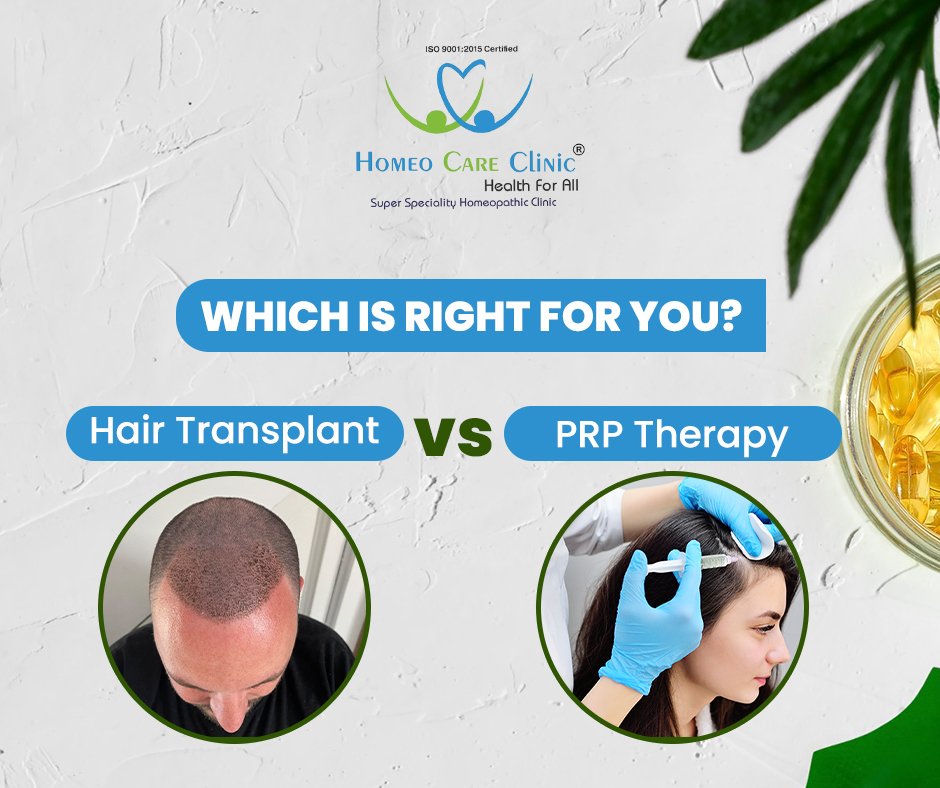Hair Transplant vs. PRP Therapy: Which is Right for You?
Hair loss is a common problem that affects both men and women. Whether your hair loss is driven by genetics, stress, hormonal imbalance, poor hair care, or an underlying medical condition, the impact of hair loss can be significant. Fortunately, advancements in medical science have led to effective hair loss treatment options, out of which FUE hair transplant and PRP therapy are the most popular. In this blog, we will discuss the key differences between PRP therapy and Hair transplant.
What is PRP Therapy?
PRP Hair treatment is a simple 3-step procedure that helps to reduce the frequency of hair loss in different conditions. A small amount of your blood is drawn, which is processed using a centrifuge to create platelet-rich plasma. This solution is then injected into the scalp to stimulate the natural growth of the hair. As growth factors concentrate in platelets as an active ingredient, these factors enhance tissue repair processes to make hair follicles create stronger, healthier hair. It is a safe and highly effective way to promote natural growth by increasing blood flow in the hair, which results in the thickness of the hair shaft.
Benefits of PRP Therapy:
- Simple, nonsurgical procedure.
- Multiple Injections: procedure lasting approximately 60 minutes.
- Safe and reliable results.
- Very quick recovery period.
- Beautiful and, above all, extremely natural-looking results
How Does PRP Work?
PRP Hair treatment involves drawing a small amount of blood, processing it to extract growth factors, and injecting it into the scalp to stimulate the natural growth of the hair. Our blood plasma (PRP) contains active growth factors that can promote hair growth.
Here’s the process of PRP Therapy:
- Consultation: Assess the scalp condition with a Dermatologist.
- Scalp Cleansing: Before starting the procedure, we clean the scalp for better results.
- Blood Drawn: Collect the sample from the patient (10-20 ml)
- Configuration Process: Spin the blood in a configuration to separate the Platelet-Rich Plasma from blood components.
- Topical Numbing: An anaesthetic cream will be applied to reduce the discomfort.
- Injecting the PRP: Precisely inject the PRP into the targeted area of the scalp for hair growth
What is FUE Hair Transplant?
Follicular Unit Extraction (FUE) is a surgical hair loss treatment procedure that involves using a miniature punch tool to remove single hair follicular units from the back or sides of the scalp and implanting them onto the bald or thinning areas. This helps to restore hair growth naturally and offers effective results for people suffering from baldness, receding hairlines, or hair thinning. It is a minimally invasive procedure that requires no stitches or incisions. There are no visible scars, which makes this treatment suitable for people who like shorter hairstyles.
Which is Better: PRP or Hair Transplant?
When it comes to hair loss treatments, there is no one-size-fits-all solution. The best option depends on the severity of your hair loss, the desired outcome, and your personal preferences.
- Effectiveness
- PRP: This treatment is suitable for people with the beginning stages of hair loss or thinning. The regrowth of new hair remains temporary since this treatment does not help heal severe bald spots on the scalp.
- Hair Transplant: It is a highly effective treatment for permanent hair restoration, especially in those people with extreme cases of hair loss. The procedure promises natural-looking results yet needs several interventions to reach the best possible result, especially when addressing serious baldness.
- Procedure
- PRP: It is a non-invasive procedure that needs little to no recovery time. Many people who undergo this treatment need 30 to 60 minutes of procedure time before they can resume their day-to-day activities.
- Hair Transplant: This treatment is a surgical procedure, which means it requires more recovery time after the procedure. Before the procedure, you may need to plan your time as after the surgery you may have swelling and soreness, which may lead to scabbing that requires several days or weeks to heal.
- Results
- PRP: When undergoing this treatment, you should expect results to emerge after several months and may even multiple sessions to achieve your desired result. You may also need additional PRP treatments, as this method does not provide a permanent hair loss solution.
- Hair Transplant: The results of this treatment appear quickly and are a permanent solution for hair restoration. The new hair follicles that receive transplantation will start their growth process between 3-6 months, and the complete results become visible within about 1 year.
- Side Effects
- PRP: This treatment uses your blood, which results in minimal adverse side effects. You may experience light swelling or minor irritation in the injection area, which goes away in some time. Some people may have bruising, although it disappears in a few days.
- Hair Transplant: Since it is a surgical procedure, you may have some side effects that could result in infection, scarring, and poor graft survival. Following the post-procedure care properly will help you reduce potential risks.
Conclusion
Both PRP therapy and FUE Hair transplant are dependable hair restoration treatments that address separate therapeutic demands. PRP is a suitable solution when you have early signs of hair loss or thinning and need a minimally invasive procedure. Whereas hair transplant is an effective solution for advanced baldness and gives permanent and natural-looking results. The treatment decision depends on the severity of your hair loss, your budget, and the results you are looking for. At Homeocare Clinic, we are dedicated to providing our patients with the best quality and personalised treatment plans tailored to fulfil their specific requirements. Our experienced team of dermatologists offers safe, natural, and highly effective solutions to promote the regrowth of our patients’ hair. Contact us now for the best hair treatment in Pune.



